Business Law Assignment: Contract, Property Law Analysis and Debts
VerifiedAdded on 2021/05/30
|6
|1686
|51
Homework Assignment
AI Summary
This business law assignment analyzes two scenarios. The first involves a dispute over misrepresented offers and exclusion clauses in a contract for the sale of music discs. The assignment examines whether the buyer, Annie, has grounds to return the discs and recover her money, focusing on misrepresentation and the application of the contra proferentem rule. The second scenario involves a property dispute between joint tenants, Dodo and Pina, concerning a vacant land. The assignment explores the liabilities of joint owners for debts incurred by one party, even without the other's knowledge, considering the principles of joint tenancy, property rights, and obligations. The document uses case law to support its arguments and concludes that Annie can return the discs and Dodo is liable for the debts incurred by Pina.
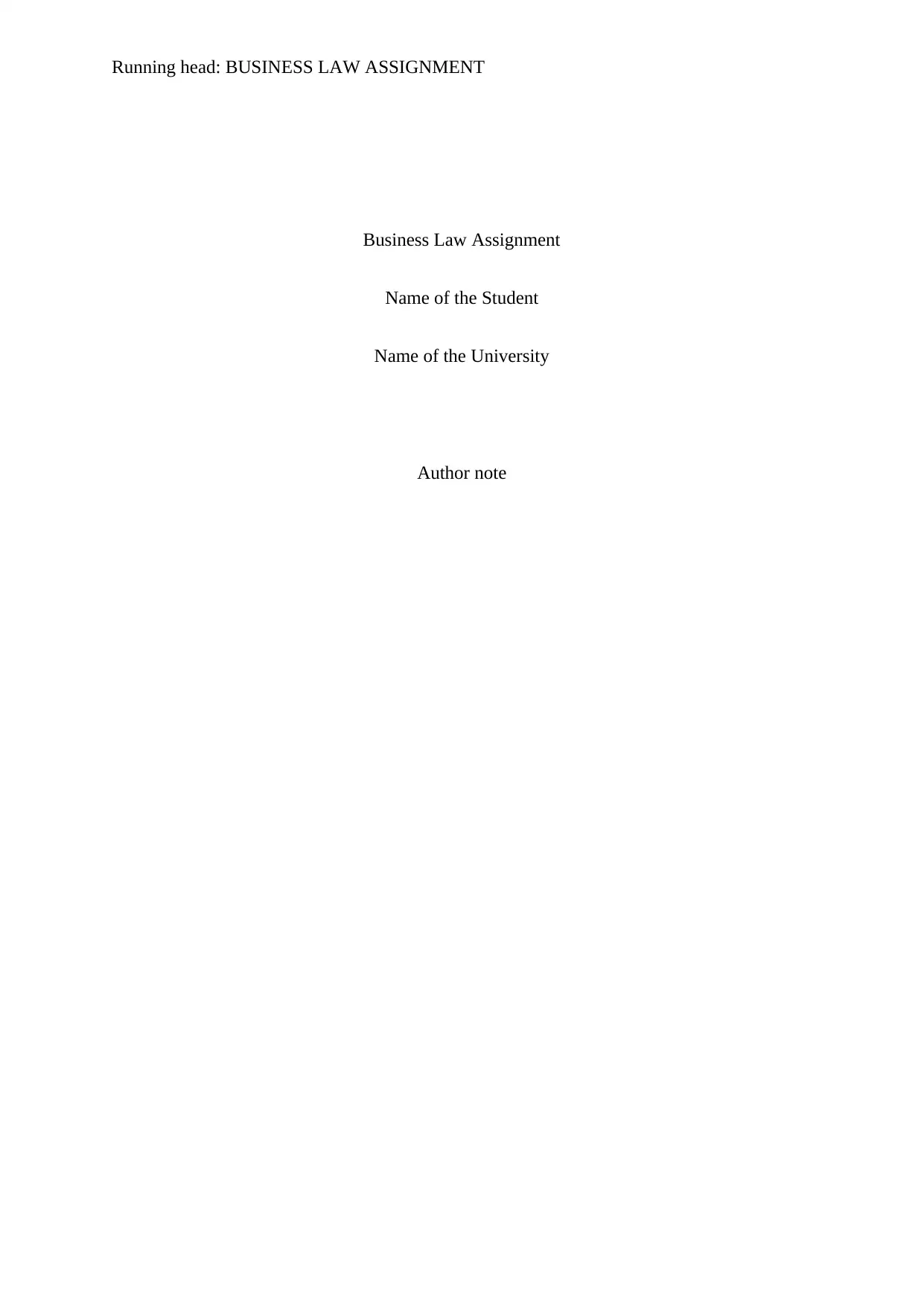
Running head: BUSINESS LAW ASSIGNMENT
Business Law Assignment
Name of the Student
Name of the University
Author note
Business Law Assignment
Name of the Student
Name of the University
Author note
Paraphrase This Document
Need a fresh take? Get an instant paraphrase of this document with our AI Paraphraser
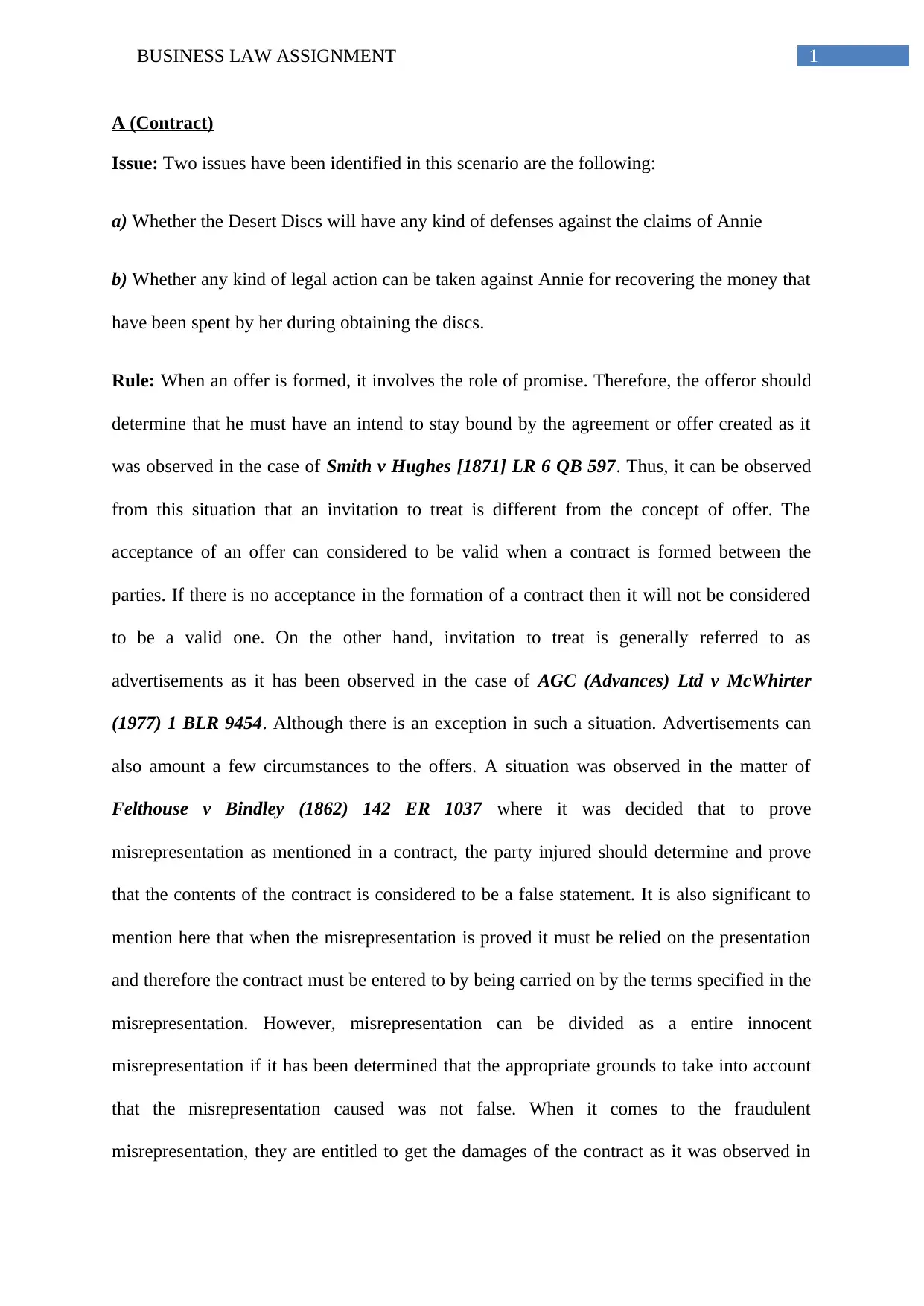
1BUSINESS LAW ASSIGNMENT
A (Contract)
Issue: Two issues have been identified in this scenario are the following:
a) Whether the Desert Discs will have any kind of defenses against the claims of Annie
b) Whether any kind of legal action can be taken against Annie for recovering the money that
have been spent by her during obtaining the discs.
Rule: When an offer is formed, it involves the role of promise. Therefore, the offeror should
determine that he must have an intend to stay bound by the agreement or offer created as it
was observed in the case of Smith v Hughes [1871] LR 6 QB 597. Thus, it can be observed
from this situation that an invitation to treat is different from the concept of offer. The
acceptance of an offer can considered to be valid when a contract is formed between the
parties. If there is no acceptance in the formation of a contract then it will not be considered
to be a valid one. On the other hand, invitation to treat is generally referred to as
advertisements as it has been observed in the case of AGC (Advances) Ltd v McWhirter
(1977) 1 BLR 9454. Although there is an exception in such a situation. Advertisements can
also amount a few circumstances to the offers. A situation was observed in the matter of
Felthouse v Bindley (1862) 142 ER 1037 where it was decided that to prove
misrepresentation as mentioned in a contract, the party injured should determine and prove
that the contents of the contract is considered to be a false statement. It is also significant to
mention here that when the misrepresentation is proved it must be relied on the presentation
and therefore the contract must be entered to by being carried on by the terms specified in the
misrepresentation. However, misrepresentation can be divided as a entire innocent
misrepresentation if it has been determined that the appropriate grounds to take into account
that the misrepresentation caused was not false. When it comes to the fraudulent
misrepresentation, they are entitled to get the damages of the contract as it was observed in
A (Contract)
Issue: Two issues have been identified in this scenario are the following:
a) Whether the Desert Discs will have any kind of defenses against the claims of Annie
b) Whether any kind of legal action can be taken against Annie for recovering the money that
have been spent by her during obtaining the discs.
Rule: When an offer is formed, it involves the role of promise. Therefore, the offeror should
determine that he must have an intend to stay bound by the agreement or offer created as it
was observed in the case of Smith v Hughes [1871] LR 6 QB 597. Thus, it can be observed
from this situation that an invitation to treat is different from the concept of offer. The
acceptance of an offer can considered to be valid when a contract is formed between the
parties. If there is no acceptance in the formation of a contract then it will not be considered
to be a valid one. On the other hand, invitation to treat is generally referred to as
advertisements as it has been observed in the case of AGC (Advances) Ltd v McWhirter
(1977) 1 BLR 9454. Although there is an exception in such a situation. Advertisements can
also amount a few circumstances to the offers. A situation was observed in the matter of
Felthouse v Bindley (1862) 142 ER 1037 where it was decided that to prove
misrepresentation as mentioned in a contract, the party injured should determine and prove
that the contents of the contract is considered to be a false statement. It is also significant to
mention here that when the misrepresentation is proved it must be relied on the presentation
and therefore the contract must be entered to by being carried on by the terms specified in the
misrepresentation. However, misrepresentation can be divided as a entire innocent
misrepresentation if it has been determined that the appropriate grounds to take into account
that the misrepresentation caused was not false. When it comes to the fraudulent
misrepresentation, they are entitled to get the damages of the contract as it was observed in
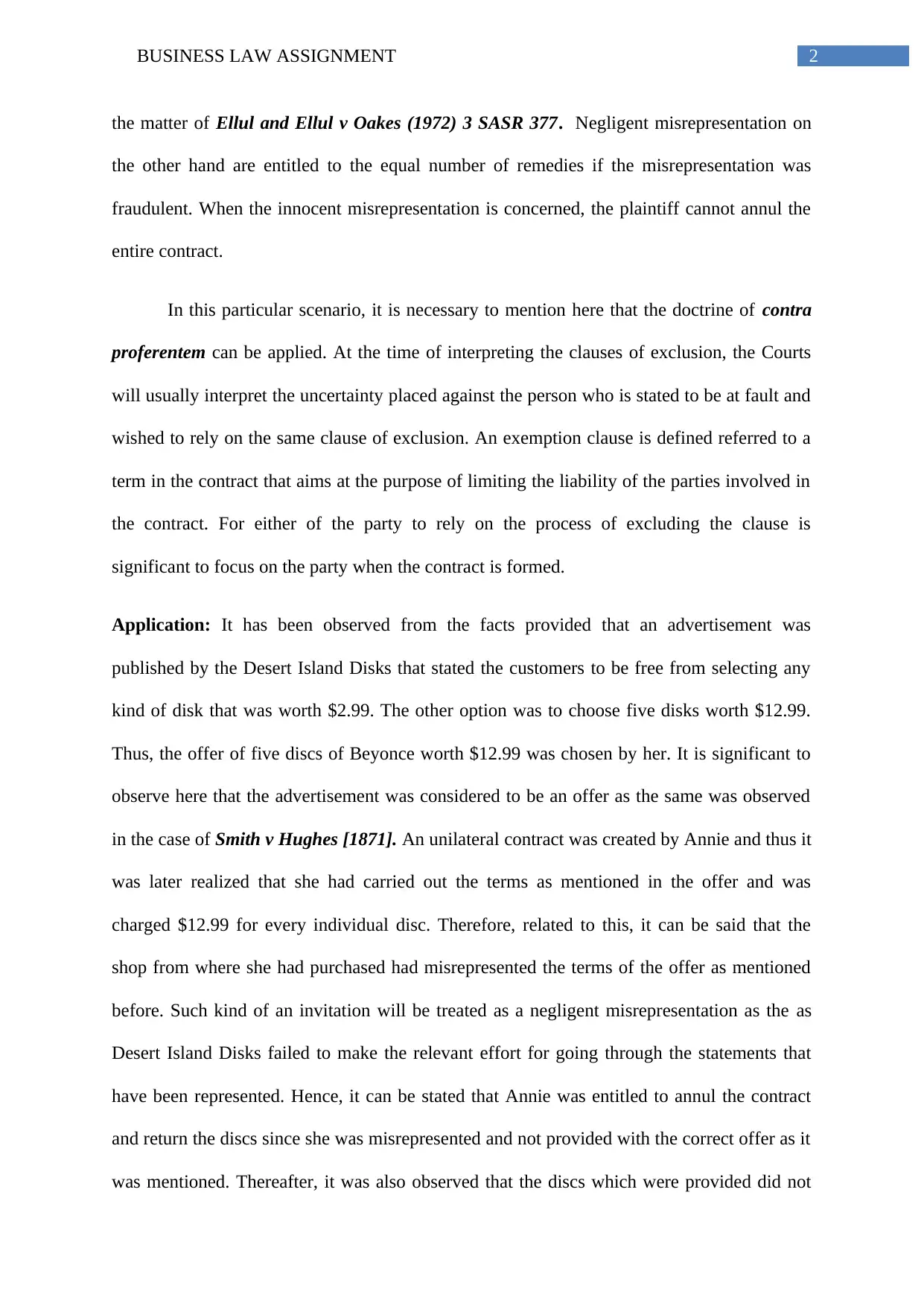
2BUSINESS LAW ASSIGNMENT
the matter of Ellul and Ellul v Oakes (1972) 3 SASR 377. Negligent misrepresentation on
the other hand are entitled to the equal number of remedies if the misrepresentation was
fraudulent. When the innocent misrepresentation is concerned, the plaintiff cannot annul the
entire contract.
In this particular scenario, it is necessary to mention here that the doctrine of contra
proferentem can be applied. At the time of interpreting the clauses of exclusion, the Courts
will usually interpret the uncertainty placed against the person who is stated to be at fault and
wished to rely on the same clause of exclusion. An exemption clause is defined referred to a
term in the contract that aims at the purpose of limiting the liability of the parties involved in
the contract. For either of the party to rely on the process of excluding the clause is
significant to focus on the party when the contract is formed.
Application: It has been observed from the facts provided that an advertisement was
published by the Desert Island Disks that stated the customers to be free from selecting any
kind of disk that was worth $2.99. The other option was to choose five disks worth $12.99.
Thus, the offer of five discs of Beyonce worth $12.99 was chosen by her. It is significant to
observe here that the advertisement was considered to be an offer as the same was observed
in the case of Smith v Hughes [1871]. An unilateral contract was created by Annie and thus it
was later realized that she had carried out the terms as mentioned in the offer and was
charged $12.99 for every individual disc. Therefore, related to this, it can be said that the
shop from where she had purchased had misrepresented the terms of the offer as mentioned
before. Such kind of an invitation will be treated as a negligent misrepresentation as the as
Desert Island Disks failed to make the relevant effort for going through the statements that
have been represented. Hence, it can be stated that Annie was entitled to annul the contract
and return the discs since she was misrepresented and not provided with the correct offer as it
was mentioned. Thereafter, it was also observed that the discs which were provided did not
the matter of Ellul and Ellul v Oakes (1972) 3 SASR 377. Negligent misrepresentation on
the other hand are entitled to the equal number of remedies if the misrepresentation was
fraudulent. When the innocent misrepresentation is concerned, the plaintiff cannot annul the
entire contract.
In this particular scenario, it is necessary to mention here that the doctrine of contra
proferentem can be applied. At the time of interpreting the clauses of exclusion, the Courts
will usually interpret the uncertainty placed against the person who is stated to be at fault and
wished to rely on the same clause of exclusion. An exemption clause is defined referred to a
term in the contract that aims at the purpose of limiting the liability of the parties involved in
the contract. For either of the party to rely on the process of excluding the clause is
significant to focus on the party when the contract is formed.
Application: It has been observed from the facts provided that an advertisement was
published by the Desert Island Disks that stated the customers to be free from selecting any
kind of disk that was worth $2.99. The other option was to choose five disks worth $12.99.
Thus, the offer of five discs of Beyonce worth $12.99 was chosen by her. It is significant to
observe here that the advertisement was considered to be an offer as the same was observed
in the case of Smith v Hughes [1871]. An unilateral contract was created by Annie and thus it
was later realized that she had carried out the terms as mentioned in the offer and was
charged $12.99 for every individual disc. Therefore, related to this, it can be said that the
shop from where she had purchased had misrepresented the terms of the offer as mentioned
before. Such kind of an invitation will be treated as a negligent misrepresentation as the as
Desert Island Disks failed to make the relevant effort for going through the statements that
have been represented. Hence, it can be stated that Annie was entitled to annul the contract
and return the discs since she was misrepresented and not provided with the correct offer as it
was mentioned. Thereafter, it was also observed that the discs which were provided did not
⊘ This is a preview!⊘
Do you want full access?
Subscribe today to unlock all pages.

Trusted by 1+ million students worldwide
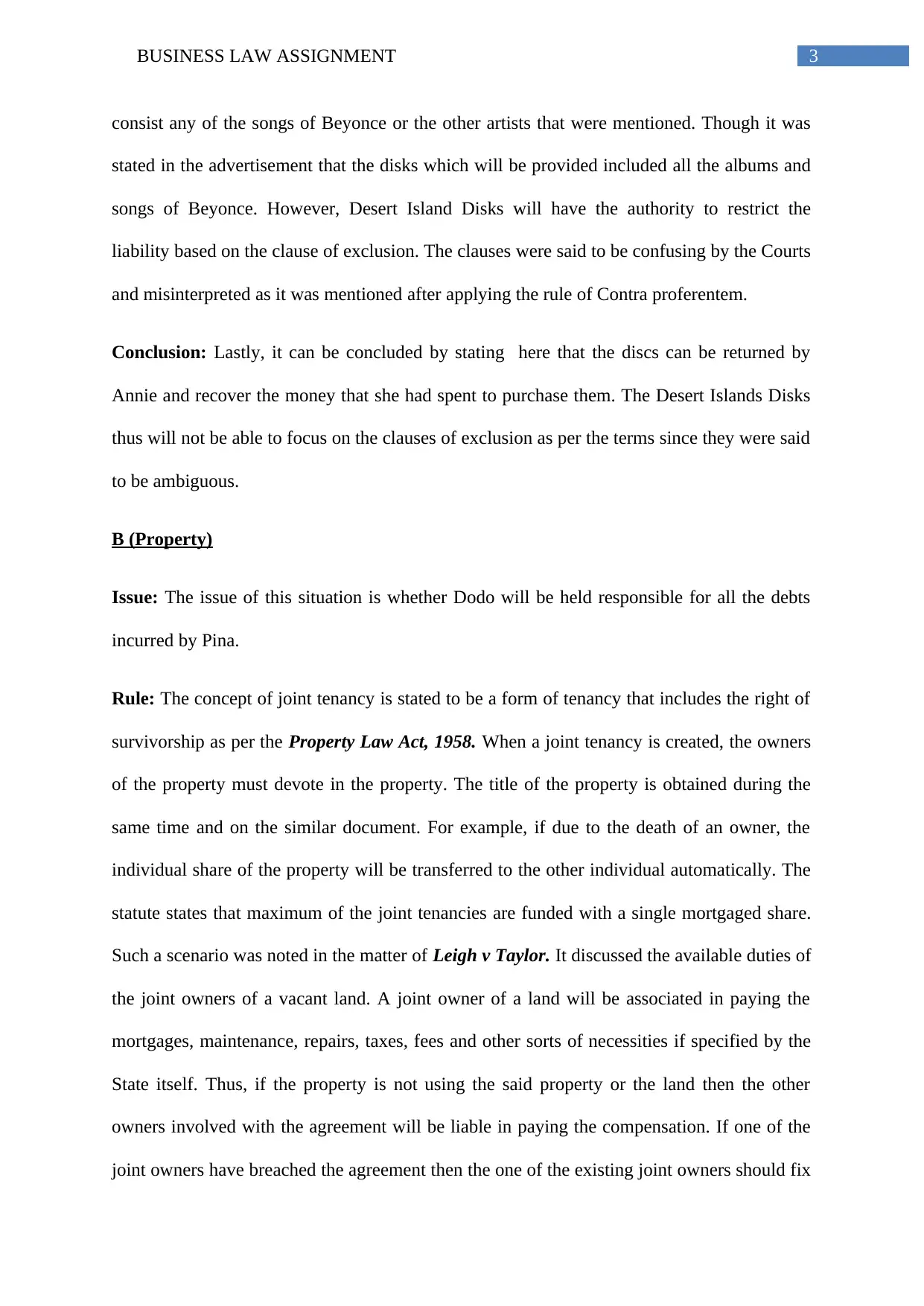
3BUSINESS LAW ASSIGNMENT
consist any of the songs of Beyonce or the other artists that were mentioned. Though it was
stated in the advertisement that the disks which will be provided included all the albums and
songs of Beyonce. However, Desert Island Disks will have the authority to restrict the
liability based on the clause of exclusion. The clauses were said to be confusing by the Courts
and misinterpreted as it was mentioned after applying the rule of Contra proferentem.
Conclusion: Lastly, it can be concluded by stating here that the discs can be returned by
Annie and recover the money that she had spent to purchase them. The Desert Islands Disks
thus will not be able to focus on the clauses of exclusion as per the terms since they were said
to be ambiguous.
B (Property)
Issue: The issue of this situation is whether Dodo will be held responsible for all the debts
incurred by Pina.
Rule: The concept of joint tenancy is stated to be a form of tenancy that includes the right of
survivorship as per the Property Law Act, 1958. When a joint tenancy is created, the owners
of the property must devote in the property. The title of the property is obtained during the
same time and on the similar document. For example, if due to the death of an owner, the
individual share of the property will be transferred to the other individual automatically. The
statute states that maximum of the joint tenancies are funded with a single mortgaged share.
Such a scenario was noted in the matter of Leigh v Taylor. It discussed the available duties of
the joint owners of a vacant land. A joint owner of a land will be associated in paying the
mortgages, maintenance, repairs, taxes, fees and other sorts of necessities if specified by the
State itself. Thus, if the property is not using the said property or the land then the other
owners involved with the agreement will be liable in paying the compensation. If one of the
joint owners have breached the agreement then the one of the existing joint owners should fix
consist any of the songs of Beyonce or the other artists that were mentioned. Though it was
stated in the advertisement that the disks which will be provided included all the albums and
songs of Beyonce. However, Desert Island Disks will have the authority to restrict the
liability based on the clause of exclusion. The clauses were said to be confusing by the Courts
and misinterpreted as it was mentioned after applying the rule of Contra proferentem.
Conclusion: Lastly, it can be concluded by stating here that the discs can be returned by
Annie and recover the money that she had spent to purchase them. The Desert Islands Disks
thus will not be able to focus on the clauses of exclusion as per the terms since they were said
to be ambiguous.
B (Property)
Issue: The issue of this situation is whether Dodo will be held responsible for all the debts
incurred by Pina.
Rule: The concept of joint tenancy is stated to be a form of tenancy that includes the right of
survivorship as per the Property Law Act, 1958. When a joint tenancy is created, the owners
of the property must devote in the property. The title of the property is obtained during the
same time and on the similar document. For example, if due to the death of an owner, the
individual share of the property will be transferred to the other individual automatically. The
statute states that maximum of the joint tenancies are funded with a single mortgaged share.
Such a scenario was noted in the matter of Leigh v Taylor. It discussed the available duties of
the joint owners of a vacant land. A joint owner of a land will be associated in paying the
mortgages, maintenance, repairs, taxes, fees and other sorts of necessities if specified by the
State itself. Thus, if the property is not using the said property or the land then the other
owners involved with the agreement will be liable in paying the compensation. If one of the
joint owners have breached the agreement then the one of the existing joint owners should fix
Paraphrase This Document
Need a fresh take? Get an instant paraphrase of this document with our AI Paraphraser
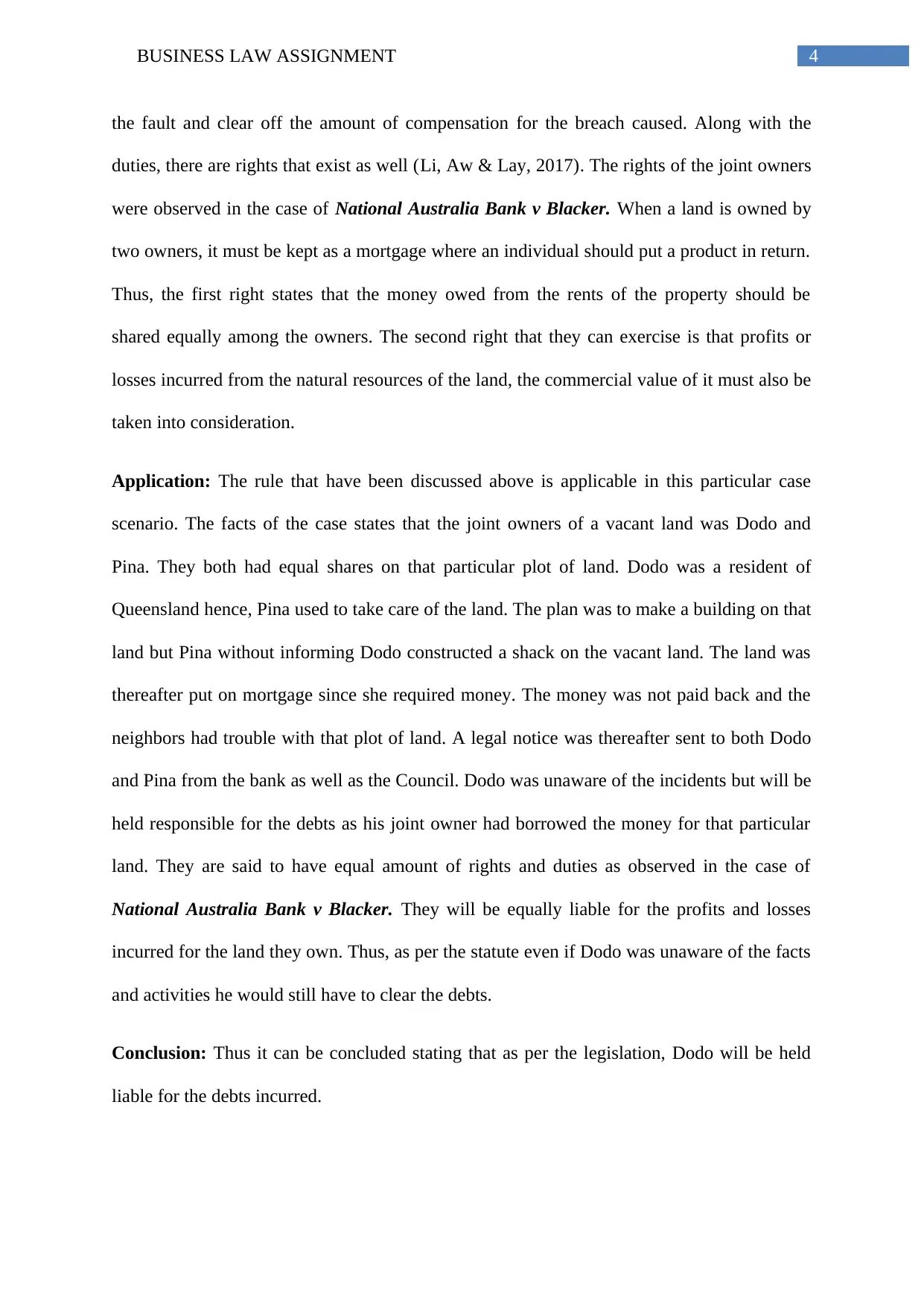
4BUSINESS LAW ASSIGNMENT
the fault and clear off the amount of compensation for the breach caused. Along with the
duties, there are rights that exist as well (Li, Aw & Lay, 2017). The rights of the joint owners
were observed in the case of National Australia Bank v Blacker. When a land is owned by
two owners, it must be kept as a mortgage where an individual should put a product in return.
Thus, the first right states that the money owed from the rents of the property should be
shared equally among the owners. The second right that they can exercise is that profits or
losses incurred from the natural resources of the land, the commercial value of it must also be
taken into consideration.
Application: The rule that have been discussed above is applicable in this particular case
scenario. The facts of the case states that the joint owners of a vacant land was Dodo and
Pina. They both had equal shares on that particular plot of land. Dodo was a resident of
Queensland hence, Pina used to take care of the land. The plan was to make a building on that
land but Pina without informing Dodo constructed a shack on the vacant land. The land was
thereafter put on mortgage since she required money. The money was not paid back and the
neighbors had trouble with that plot of land. A legal notice was thereafter sent to both Dodo
and Pina from the bank as well as the Council. Dodo was unaware of the incidents but will be
held responsible for the debts as his joint owner had borrowed the money for that particular
land. They are said to have equal amount of rights and duties as observed in the case of
National Australia Bank v Blacker. They will be equally liable for the profits and losses
incurred for the land they own. Thus, as per the statute even if Dodo was unaware of the facts
and activities he would still have to clear the debts.
Conclusion: Thus it can be concluded stating that as per the legislation, Dodo will be held
liable for the debts incurred.
the fault and clear off the amount of compensation for the breach caused. Along with the
duties, there are rights that exist as well (Li, Aw & Lay, 2017). The rights of the joint owners
were observed in the case of National Australia Bank v Blacker. When a land is owned by
two owners, it must be kept as a mortgage where an individual should put a product in return.
Thus, the first right states that the money owed from the rents of the property should be
shared equally among the owners. The second right that they can exercise is that profits or
losses incurred from the natural resources of the land, the commercial value of it must also be
taken into consideration.
Application: The rule that have been discussed above is applicable in this particular case
scenario. The facts of the case states that the joint owners of a vacant land was Dodo and
Pina. They both had equal shares on that particular plot of land. Dodo was a resident of
Queensland hence, Pina used to take care of the land. The plan was to make a building on that
land but Pina without informing Dodo constructed a shack on the vacant land. The land was
thereafter put on mortgage since she required money. The money was not paid back and the
neighbors had trouble with that plot of land. A legal notice was thereafter sent to both Dodo
and Pina from the bank as well as the Council. Dodo was unaware of the incidents but will be
held responsible for the debts as his joint owner had borrowed the money for that particular
land. They are said to have equal amount of rights and duties as observed in the case of
National Australia Bank v Blacker. They will be equally liable for the profits and losses
incurred for the land they own. Thus, as per the statute even if Dodo was unaware of the facts
and activities he would still have to clear the debts.
Conclusion: Thus it can be concluded stating that as per the legislation, Dodo will be held
liable for the debts incurred.
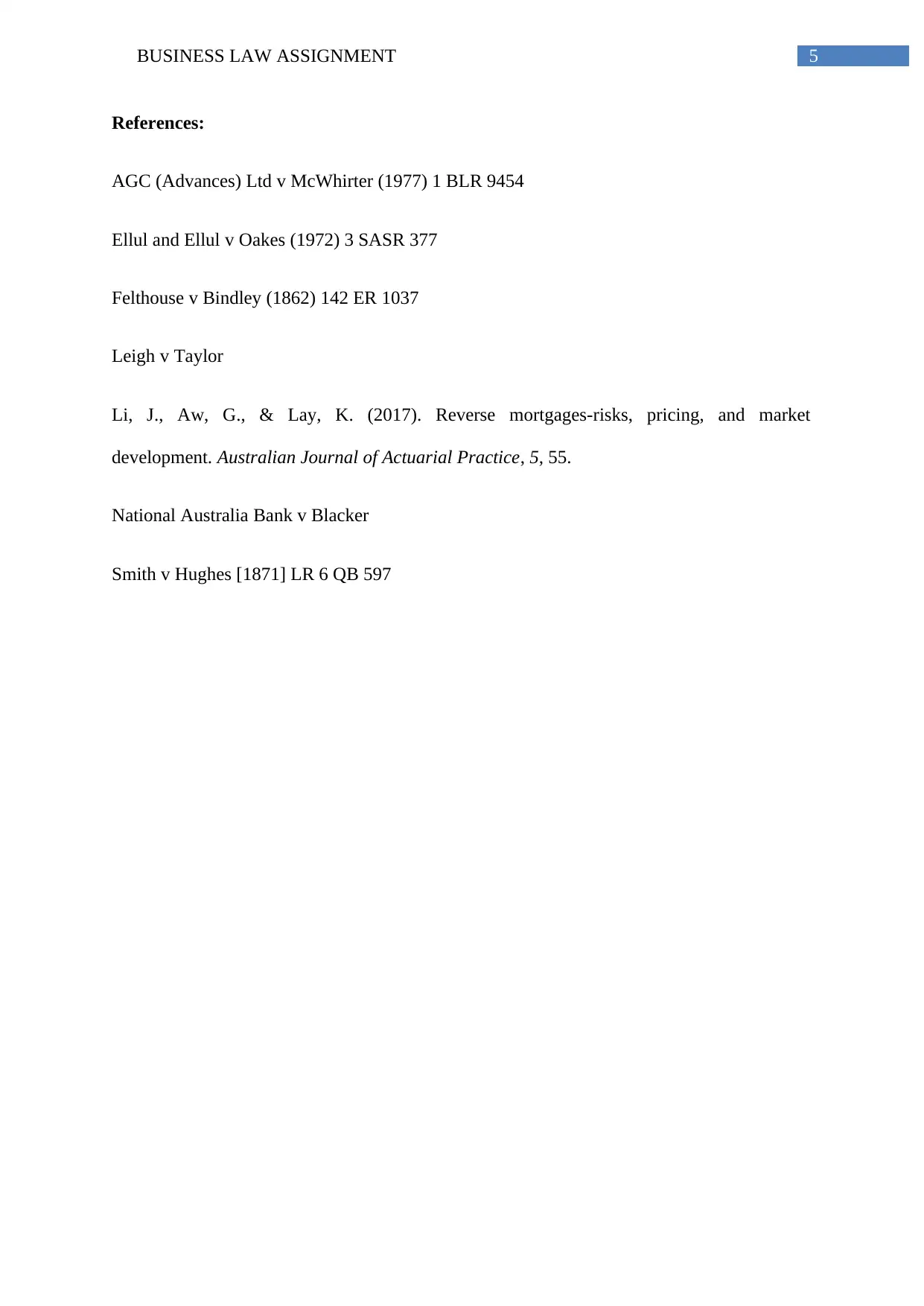
5BUSINESS LAW ASSIGNMENT
References:
AGC (Advances) Ltd v McWhirter (1977) 1 BLR 9454
Ellul and Ellul v Oakes (1972) 3 SASR 377
Felthouse v Bindley (1862) 142 ER 1037
Leigh v Taylor
Li, J., Aw, G., & Lay, K. (2017). Reverse mortgages-risks, pricing, and market
development. Australian Journal of Actuarial Practice, 5, 55.
National Australia Bank v Blacker
Smith v Hughes [1871] LR 6 QB 597
References:
AGC (Advances) Ltd v McWhirter (1977) 1 BLR 9454
Ellul and Ellul v Oakes (1972) 3 SASR 377
Felthouse v Bindley (1862) 142 ER 1037
Leigh v Taylor
Li, J., Aw, G., & Lay, K. (2017). Reverse mortgages-risks, pricing, and market
development. Australian Journal of Actuarial Practice, 5, 55.
National Australia Bank v Blacker
Smith v Hughes [1871] LR 6 QB 597
⊘ This is a preview!⊘
Do you want full access?
Subscribe today to unlock all pages.

Trusted by 1+ million students worldwide
1 out of 6
Related Documents
Your All-in-One AI-Powered Toolkit for Academic Success.
+13062052269
info@desklib.com
Available 24*7 on WhatsApp / Email
![[object Object]](/_next/static/media/star-bottom.7253800d.svg)
Unlock your academic potential
Copyright © 2020–2025 A2Z Services. All Rights Reserved. Developed and managed by ZUCOL.





